Full Stack Development Internship Program
- 29k Enrolled Learners
- Weekend/Weekday
- Live Class
The job market is constantly evolving and shifting rapidly these days, so workers need to know about reskilling and upskilling to stay ahead of the competition. Continuous learning was once considered a luxury, but as businesses change and new technologies come out, it’s become a must. This blog post talks about the differences between upskilling and reskilling, as well as their value, benefits, and how to do them effectively.
Companies are putting more money into employee development to keep good workers and encourage new ideas. Siemens for instance, set up an apprenticeship program that mixed classroom learning with training on the job. This project not only fixed the problem of a lack of skills, but it also made it clear to workers how they could move up, which made them happier at work and kept them from leaving.
Professionals who are trying to advance in their careers need to know the differences between reskilling and upskilling.
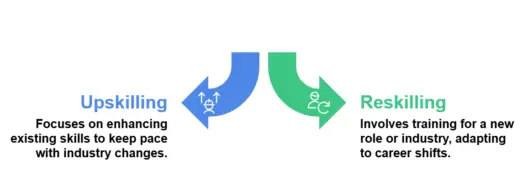
Upskilling means improving the skills you already have to do a better job in your current work. It’s about getting better at what you do and keeping up with changes in the field. One example of upskilling is a digital marketer who learns how to use advanced data analytics tools to make efforts more effective.
On the other hand, getting new skills to move into a different job or industry is called reskilling. It is a plan for people who want to change jobs or adjust to big changes in the field they are currently working in. One example of reskilling is a logistics worker who learns how to make software work in the tech industry.
Now that we have a better understanding of these ideas, let’s look at how they are different.
| Aspect | Upskilling | Reskilling |
| Objective | Improve the skills you already have to do a better job in your current work. | Learn new skills to help you move into a new job or industry. |
| Scope | Designed to help professionals advance in their present position. | Usually means making a big career change or adapting to changes in the business. |
| Application | Great for getting ahead in your field and staying competitive. | Good for when your current skills are becoming useless or when you want to change careers. |
| Example | An accountant who is learning more advanced methods for financial modeling. | A teacher who is learning to code to become a software coder. |
Upskilling and Reskilling are both important for job growth, but they are used for different things and in different situations.
Consider it when-
Consider it when-
It is very important to know when to reskill or upskill. We will now talk about why these methods are so important in 2025.
The year 2025 brings new problems and chances, which makes learning new things more important than ever.
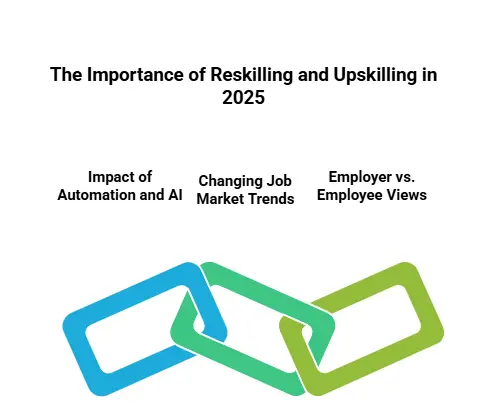
Automation and artificial intelligence (AI) are changing many fields. Routine chores are being done by machines, and new jobs are being created that require advanced tech skills. A study from the World Economic Forum says that because of changes in technology, half of all workers will need to learn new skills by 2025.
More and more, the job market is looking for workers who can keep up with fast changes in technology. More and more people want to hire people with skills in digital marketing, data analysis, and safety. Professionals who keep learning are better prepared to take advantage of new chances.
Employers know that spending in the growth of their workers makes them more productive and more likely to stay with the company. A LinkedIn poll found that 94% of workers would stay with a company longer if it helped them grow. Upskilling and reskilling are important for employees to advance in their careers and keep their jobs in a competitive job market. Why is it so important for companies to reskill & upskill employees?
Now that you know why continuous learning is important, let’s look at the rewards it brings.
Getting new skills and improving old ones can be very helpful for both workers and businesses.
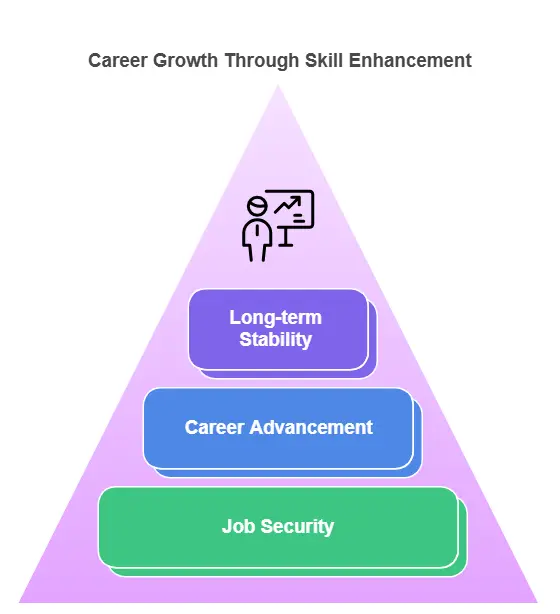
Employers are more likely to hire professionals with up-to-date skills, which makes jobs safer. Getting new skills can lead to new job opportunities, especially in new fields. Disprz did a study that showed that upskilling leads to better retention rates and more work getting done.
Getting new skills is often linked to higher salaries and moving up in your job. According to data, there is a strong link between getting new skills and raising your salary. People who work as professionals and put effort into learning are more likely to get promoted and get paid more.
Professionals stay useful in their fields by learning new things all the time and adapting to changes in business and new technologies. This ability to adapt helps a job last for a long time.
Now that we know what the benefits are, let’s look at which businesses need reskilling and upskilling programs the most.
As the global economy changes quickly, big changes are happening in some fields. To keep up with changing needs, people need to focus on reskilling and upskilling.
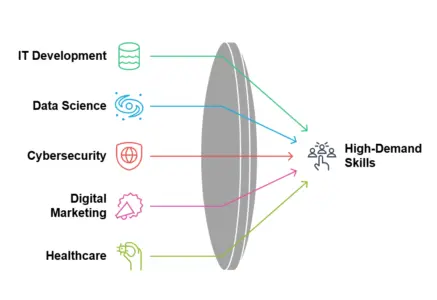
The software development and information technology (IT) industries are still at the cutting edge of new ideas. Since new programming languages, frameworks, and methods are always coming out, people who work in this field need to keep learning to stay current. The need for specialized skills has grown even more since artificial intelligence (AI) and machine learning (ML) were added to software solutions. IT workers can improve their chances of getting hired and doing a better job for their companies by learning new skills in areas like cloud computing, cybersecurity, and DevOps.
In the age of “big data,” being able to look at and understand large amounts of data is very useful. All kinds of industries are using data-driven insights to help them make decisions and plan their strategies. Because of this, there is a huge need for data scientists and researchers who are good at statistical analysis, data visualization, and making predictions. Learning new skills in this area can lead to job chances in fields like healthcare and finance, where data is essential for planning and running operations.
Cybersecurity has become a very important issue for businesses all over the world as online threats get more common and more complex. As more people work from home and more devices connect to the internet, the attack surface has grown. Strong security steps are now necessary. People who know a lot about network security, safe hacking, and evaluating risks are in high demand. Learning more about hacking not only makes jobs safer but also puts people in charge of protecting company assets.
The digitalization of encounters with customers has changed the way marketers do their jobs. Digital marketing methods that use AI and data analytics are being used in addition to or instead of traditional marketing methods. More and more, people want to hire people with skills in search engine optimization (SEO), content marketing, social media planning, and AI-driven customer insights. Professionals who learn more about these topics can run focused campaigns and get measurable results, which is in line with how marketing works today.
The healthcare business is changing because of new medical technologies and an aging world population. More and more people are needed who know how to use complex medical equipment, keep track of electronic health information, and set up telemedicine solutions. Changing your skills to work in healthcare technology can lead to satisfying jobs that help patients get better care and make the system work better.
You can start your professional growth journey by learning about the fields where reskilling and upskilling are most useful.
Now, let’s look at a structured way to start this process of change.
A strategic method is needed to make sure that reskilling or upskilling is done in a way that is effective and lasts.
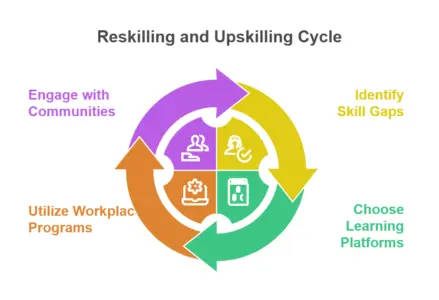
The first step is to look at your present skills and figure out what you need to work on or improve. You can learn a lot about the skills that are in demand in the field you want to work in by using self-assessment tools, getting comments from peers and supervisors, and reading industry reports. This process lets you make sure that your learning goals are in line with the needs of the job market and your own work goals.
There are many learning tools out there, so picking the right one is very important. Online learning platforms like Coursera, Udemy, and EdX have a lot of different classes in many different fields. Certifications and bootcamps that are specific to an industry can also be very good ways to learn. It can help to make smart choices by looking at things like course material, instructor expertise, accreditation, and peer reviews.
A lot of companies put money into their employees’ growth by offering training programs and mentoring programs. Using these tools can help you learn in a structured way and get personalized help. One of the best things about mentoring is that it lets you learn from more experienced professionals who can give you advice on how to move up in your job and keep up with industry trends.
Joining online communities and business networks makes it easier to share information and work together. You can meet with peers, share your experiences, and stay up to date on changes in your field through sites like LinkedIn, industry forums, and specialized groups. Participating in these communities can help people learn and give them access to new possibilities.
The process of reskilling and upskilling can be satisfying, but it can also be hard. Dealing with these problems ahead of time can make your learning trip more effective.
Reskilling and upskilling programs often have to deal with a number of problems that can slow them down.
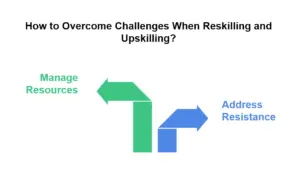
Time management skills are needed to balance learning with work and home obligations. putting realistic goals, setting aside specific times to study, and using tools for time management can all help with this. Problems can also arise when there are not enough funds. This problem can be fixed by looking into cheap ways to learn, like taking free classes at reputable schools. For example, sites like Edureka, Coursera and edX let you take high-quality classes for a cheaper price.
One common psychological block that gets in the way of learning is a dislike of change. Having a growth mindset, making small goals, and asking for help from peers and mentors can all help you get past this resistance. Realizing the long-term benefits of improving your skills can also push you to keep going when things get tough.
As we look ahead, new trends will have even more of an effect on professional growth.
Technological progress and changing ideas about how to teach are changing the future of professional growth.
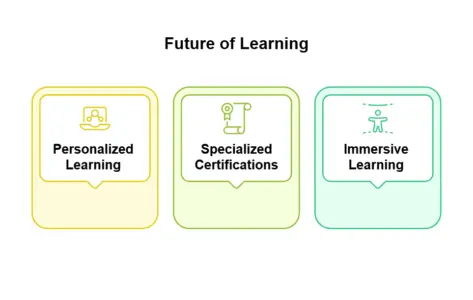
Artificial intelligence (AI) is changing the way people learn by making lessons more personalized. AI algorithms look at how people learn and what they like to customize material so that people can learn more effectively. This method not only gets people more interested, but it also speeds up the learning process, making it more useful and in line with job goals.
More and more people are using micro-credentials because they prove special skills. Professionals who want to improve their skills but don’t want to commit to long degree programs will like these short diplomas the most. They give you more freedom and often match the needs of the industry better, which makes it easier to get a job in a competitive market.
Immersive technologies like Augmented Reality (AR) and Virtual Reality (VR) are changing the way people learn. By simulating situations that happen in the real world, these tools provide interesting and useful chances to learn by doing. For example, VR can make complicated environments so that people can practice without the risks that come with real life. This makes it very useful in fields like engineering and healthcare.
Adopting these trends can make it much easier to adapt and do well in a constantly changing work world.
Today, when technology is changing quickly and the job market is always changing, it’s more important than ever to upskill and reskill. These proactive approaches to professional growth not only help people advance in their careers but also help companies be more resilient and come up with new ideas. Professionals can confidently and quickly handle the challenges of today’s workplace by identifying skill gaps, using the right learning tools, and following new educational trends. Because of this, committing to ongoing learning is not just a choice; it’s a must for long-term job success.